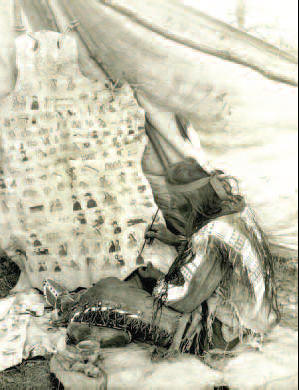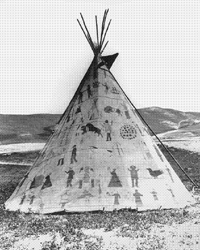 Kills Two (Lakota) in a
posed photo of a winter count keeper. Photograph by John Anderson. National
Anthropological Archives, Smithsonian Institution NAA INV 03494000
Kills Two (Lakota) in a
posed photo of a winter count keeper. Photograph by John Anderson. National
Anthropological Archives, Smithsonian Institution NAA INV 03494000History 3010
One Vast Winter Count
 Kills Two (Lakota) in a
posed photo of a winter count keeper. Photograph by John Anderson. National
Anthropological Archives, Smithsonian Institution NAA INV 03494000
Kills Two (Lakota) in a
posed photo of a winter count keeper. Photograph by John Anderson. National
Anthropological Archives, Smithsonian Institution NAA INV 03494000
 The
Brule Tipi Cover Winter Count. Courtesy of the Nebraska State Historical
Society.
The
Brule Tipi Cover Winter Count. Courtesy of the Nebraska State Historical
Society.
 "Winter
Count," Lakota, 19th-20th century, The Minneapolis Institute of Arts
"Winter
Count," Lakota, 19th-20th century, The Minneapolis Institute of Arts
Horses. Tipis. Warriors. Buffalo. Images from
Plains Indian life circle around the center of this canvas as if on a march.
This scene does not illustrate one specific moment in time.
Instead, each figure stands for a particular year in the history of a Lakota
encampment group. Together, these images form a “winter count,” a record of the
years (or “winters”) in the tribe’s history. Stories told by the count’s
“keeper”—the community’s historian and storyteller—brought that history to life
for everyone else.
Reading: One Vast Winter Count
Prologue
Part 2
Part 3
Review from History Net: http://www.h-net.org/reviews/showrev.cgi?path=190521084353452
Review from Western Historical Quarterly: http://www.historycooperative.org/journals/whq/36.1/br_1.html
Review from The American Historical Review: http://www.historycooperative.org/journals/ahr/110.1/br_43.html
Paper # 5: Scholars have tended to represent change as something unwelcome in Native communities, as something imposed by Euro-American outsiders over Native resistance or at least reluctance. Put another way, Natives are said to have longed for the maintenance of their people’s traditional ways amid the sweeping changes of the European intrusion. Recent scholarship challenges that characterization of Native American history after European intrusions. Use One Vast Winter Count to demonstrate your understanding of recent scholarship which argues that Natives were adaptive, creative, and accommodating of European ways. Focus on the incorporation of European ideas, materials, processes by Natives which become are part of their strategies to hold on to Indian Country.